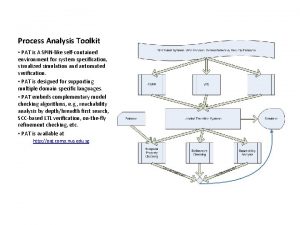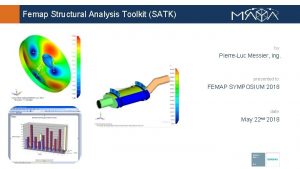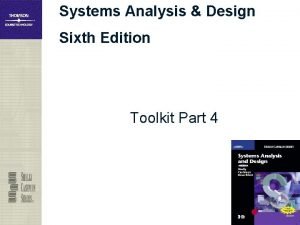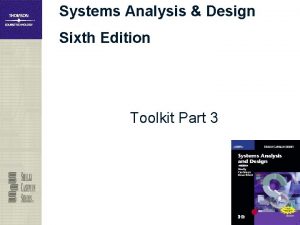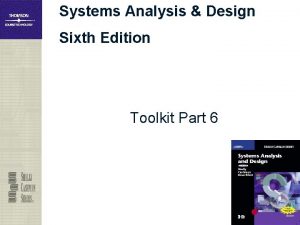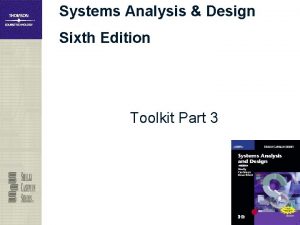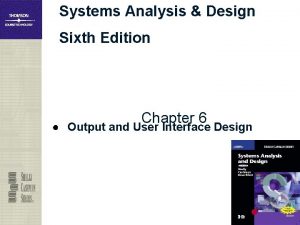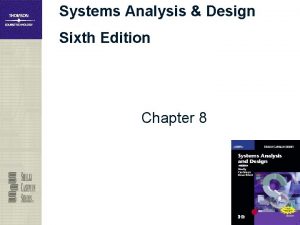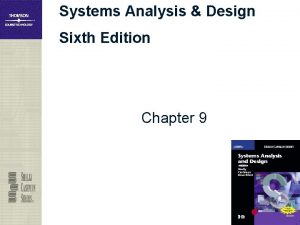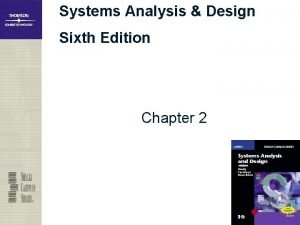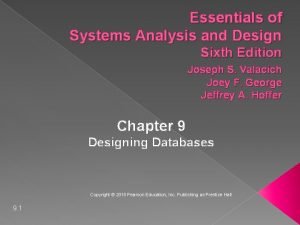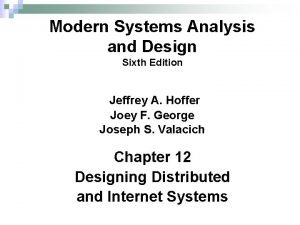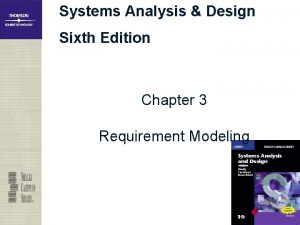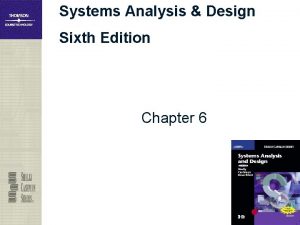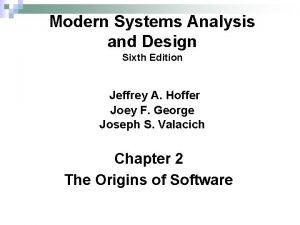Systems Analysis Design Sixth Edition Toolkit Part 2





















- Slides: 21

Systems Analysis & Design Sixth Edition Toolkit Part 2

Toolkit Objectives ● Explain CASE tools and the concept of a CASE environment ● Trace the history of CASE tools and their role in a fourth-generation environment ● Define CASE terms and concepts, including a repository, modeling tools, documentation tools, engineering tools, and construction tools 2

Toolkit Objectives ● Explain an integrated development environment ● Provide examples of CASE tools features ● Describe future trends for CASE tools, including new developments and the emerging role of object-oriented analysis and design 3

Introduction ● Computer-aided systems engineering (CASE), also called computer-aided software engineering, is a technique that uses powerful software, called CASE tools ● You will learn about integrated software development environments 4

Overview of CASE Tools ● CASE tools can reduce costs, speed up development, and provide comprehensive documentation that can be used for future maintenance or enhancements ● CASE Environment ● CASE Tools History – – As early as the 1960 s Forty years ago – procedural languages 5

Overview of CASE Tools ● CASE Tools History – Modern languages – non-procedural or eventdriven – Object-oriented programming languages (OOPL) – Fourth-generation languages (4 GLs) – Fourth-generation environment 6

Overview of CASE Tools ● The Marketplace for CASE Tools – Includes a wide variety of vendors and products, and no one tool dominates the market – The first step in learning about CASE tools is to understand basic CASE terms and concepts 7

CASE Terms and Concepts ● A typical CASE tool is actually a set of individual tools that share a repository of information ● Repository – When you define a data element in the repository, you can assign a data type and format, a range of acceptable values, and one or more aliases – Alias 8

CASE Terms and Concepts ● Individual Tools – Modeling tools – Documentation tools – Engineering tools • Forward engineering • Reverse engineering 9

CASE Terms and Concepts ● Individual Tools – Construction tools • • Application generator – code generator Screen generator Report generator – report writer Mock-up report 10

Integrated Development Environments ● Integrated development environment (IDE) ● Examples of Integrated Development Environments – Oracle Designer – Microsoft’s Visual Studio. NET 11

Integrated Development Environments ● Pros and Cons of Integrated Development Tools – Is highly effective because it is an integral part of the vendor’s software package – The only possible disadvantage is that each IDE is different, and requires a learning curve and skills that might or might not be readily transferable – CASE tools can be used in any development environment 12

CASE Tool Examples ● You can choose from dozens of vendors and CASE tools that offer a wide range of functions ● Three leading CASE tool suppliers: Visible Systems Corporation, Popkin Software, and Rational Software 13

CASE Tool Examples ● Visible Analyst – Visible Systems Corporation is an important player in the software development market – Can generate many types of models and diagrams 14

CASE Tool Examples ● System Architect – Popkin states that its product is the first fully integrated modeling tool to unify the enterprise with complete business and systems information management – Offers numerous diagrams and definitions – Also offers extensive tutorials 15

CASE Tool Examples ● Rational Software – IBM’s Rational Software offers a wide range of systems development and modeling products – Rational Software Architect – Rational Edge 16

Future Trends ● Will consist of cross-platform tools that are capable of working with data and business processes both within the enterprise and from outside customers and suppliers ● Will undoubtedly be planned, constructed, and maintained with a new generation of CASE tools 17

Future Trends ● New Features – Framework Manager – Lines between traditional CASE tools and other modeling tools continue to blur – Microsoft Visio – Another trend is represented by Microsoft’s Visual Studio. NET 18

Future Trends ● The Emerging Role of Object-Oriented Analysis and Design – Structured analysis – Systems development life cycle (SDLC) – Object-oriented analysis and design (OOAD) is gaining popularity – Features of an O-O approach include modular design and reusable code that easily can be combined and reassembled into new components 19

Toolkit Summary ● CASE tools are software programs that system developers use to help them design and construct information systems ● A repository is a database that serves as a central storage location for all information about the system being developed ● An integrated set of CASE tools can be used to model, document, engineer, and construct the information system 20

Toolkit Summary ● Forward engineering means translating business processes and functions into applications ● Two trends seem clear: CASE tool vendors will continue to include powerful new features, and the popularity of object-oriented tools will continue to grow ● Toolkit Part 2 complete 21
 Peter piper tongue twister
Peter piper tongue twister Rubber baby buggy bumpers tongue twister lyrics
Rubber baby buggy bumpers tongue twister lyrics A modern approach to systems analysis and design
A modern approach to systems analysis and design Modern systems analysis and design 7th edition
Modern systems analysis and design 7th edition Biochemistry sixth edition
Biochemistry sixth edition Computer architecture a quantitative approach sixth edition
Computer architecture a quantitative approach sixth edition Automotive technology principles diagnosis and service
Automotive technology principles diagnosis and service Automotive technology sixth edition
Automotive technology sixth edition Citation sample pdf
Citation sample pdf Computer architecture a quantitative approach 6th
Computer architecture a quantitative approach 6th Precalculus sixth edition
Precalculus sixth edition Rational people think at the margin
Rational people think at the margin Computer architecture a quantitative approach sixth edition
Computer architecture a quantitative approach sixth edition What is iot design methodology
What is iot design methodology Hamlet's sixth soliloquy analysis
Hamlet's sixth soliloquy analysis Using mis 10th edition
Using mis 10th edition Chapter 1
Chapter 1 Process analysis toolkit
Process analysis toolkit Structural analysis toolkit
Structural analysis toolkit Systems analysis and design in an age of options
Systems analysis and design in an age of options Gantt chart system analysis and design
Gantt chart system analysis and design Systems analysis and design in a changing world
Systems analysis and design in a changing world

















